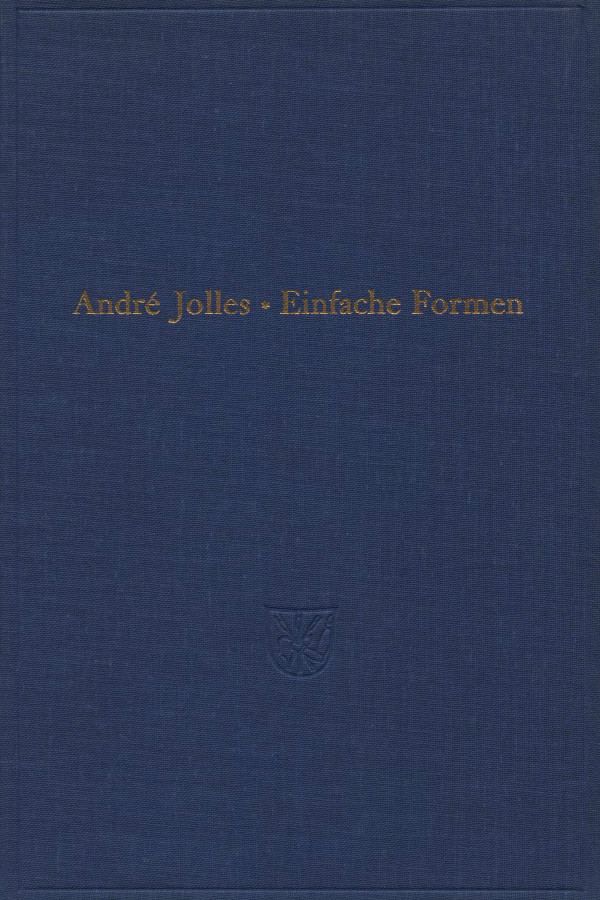André Jolles: Einfache Formen: Legende, Sage, Mythe, Ratsel, Spruch, Kasus, Memorabile, Marchen, Witz (1930–) [DE, ES]
Filed under book | Tags: · language, linguistics, literary theory, literature, narrative

Das grundlegende Konzept des Buches ist auch 50 Jahre nach Erscheinen der ersten Auflage immer noch gultig: Die Herausarbeitung der bestimmenden Konturen erzahlerischer Grundformen, die vom Autor als morphologische “Urformen” – im goetheschen Sinn – verstanden werden. In ihrer meist anonymen Erscheinungsweise nehmen sie eine Zwischenstellung zwischen “volkstumlicher” und “literarischer” Dichtung ein, was sich auch in ihrer Erforschung durch die volkskundliche und die literaturwissenschaftliche Disziplin ausdruckt.
First published in 1930
Publisher Max Niemeyer, Tübingen, 1968
272 pages
Fredric Jameson on Jolles in Brecht and Method
Wikipedia (DE)
Einfache Formen (German, 4th Edition, 1930/1968, via dbnl.org)
Einfache Formen (German, 1930/1969, no OCR)
Las formas simples (Spanish, trans. Rosemarie Kempf Titze, 1972, via Perseguidor)
Fredric Jameson: The Geopolitical Aesthetic: Cinema and Space in the World System (1992)
Filed under book | Tags: · aesthetics, capitalism, cinema, film, film theory, narrative, philosophy, politics, postmodern

Taking contemporary films from the United States, Russia, Taiwan, France, and the Philippines, The Geopolitical Aesthetic offers a reading of some of the most interesting films of the last decade and a general account of filmic representation in the postmodern world. Fredric Jameson poses some essential questions: How does representation function in contemporary film? How does contemporary cinema represent an ever more complex and international social reality? Jameson’s sophisticated and theoretically informed readings stress the ways in which disparate films—for example, Godard’s Passion, Pakula’s All the President’s Men, Yang’s The Terrorizer, Tahimik’s The Perfumed Nightmare, Tarkovsky’s Andrei Roublev—confront similar problems of representation. The solutions vary widely but the drive remains the same—the desire to find adequate allegories for our social existence.
The Geopolitical Aesthetic, a refinement and development of the arguments put forward in Jameson’s seminal work The Political Unconscious, is crucial reading for everyone interested in both film analysis and cultural studies.
Publisher Indiana University Press, 1992
Perspectives Series
ISBN 0253330939, 9780253330932
220 pages
Image, Time and Motion: New Media Critique from Turkey (2011)
Filed under book | Tags: · 2000s, critique, film, internet, narrative, net criticism, new media, technology, turkey, virtual reality

This reader is a collection of essays written by Turkish graduate students between 2003 and 2010 for Andreas Treske’s seminar ‘Image, Time and Motion’ at Bilkent University in Ankara, revised and actualized in 2010. Coming from a wide range of disciplines they had studied before, very rarely media or cultural studies, these students brought in their various viewpoints and methods, and tried to integrate their observations and understandings in a seminar related to cinema and new media to discuss and sometimes just to describe the influences of digital media technologies for themselves and their colleagues. Starting from the premise that digital technology redefines our moving image culture, the authors reflect in their essays various kind of approaches and methods, experiences and practices, descriptive, critical and interdisciplinary.
Contributors: Pelin Aytemiz, Bestem Büyüm, I. Alev Degim, Bilge Demirtas, Fulya Ertem, Deniz Hasirci, Cagri Baris Kasap, Zeynep Kocer, Rifat Süha Kocoglu, Leyla Önal, Ufuk Önen, Didem Özkul, Segah Sak, Ayda Sevin, Umut Sumnu, Andreas Treske and Funda Senova Tunali.
Edited by: Andreas Treske, Ufuk Onen, Bestem Büyüm and I. Alev Degim
Publisher: Institute of Network Cultures, Amsterdam 2011
Theory on Demand series, No 7
ISBN: 978-90-816021-5-0
146 pages

